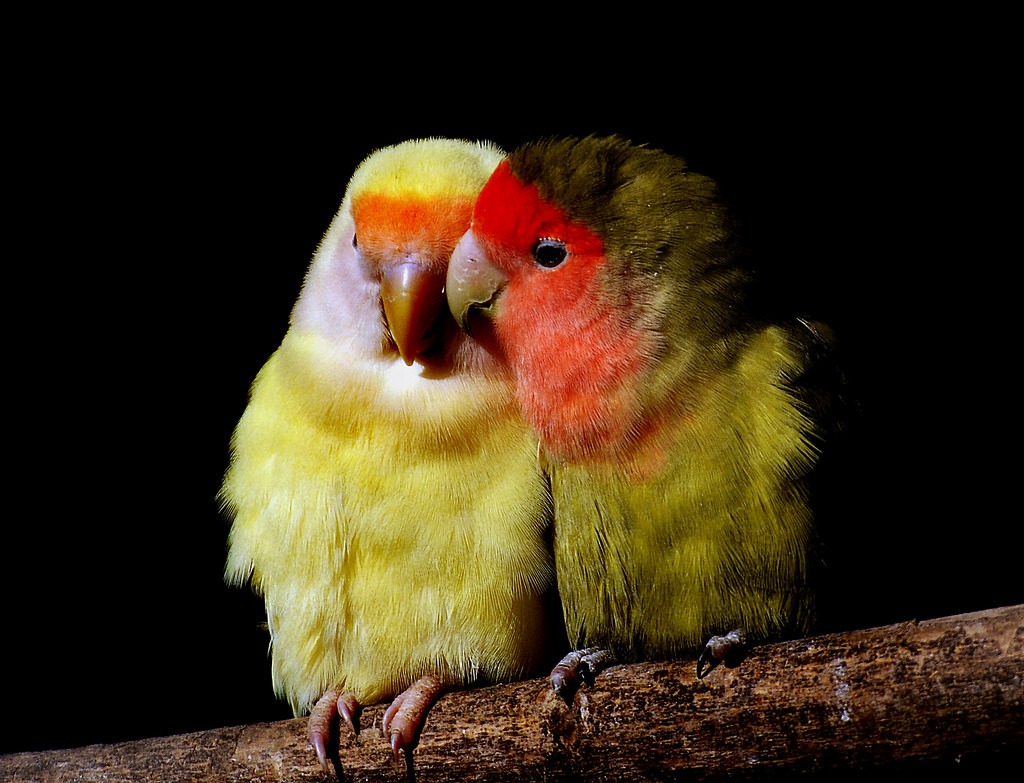Lovebirds symbolize the essence of companionship and affection, captivating bird enthusiasts worldwide with their vibrant colors and social nature. These small parrots, often seen in pairs, have a reputation for forming strong bonds with their mates, making them a fascinating subject for anyone interested in avian behavior or looking to add a feathered friend to their family. Understanding lovebirds goes beyond admiring their physical beauty; it involves recognizing their needs for social interaction, proper diet, and environmental enrichment. This post aims to shed light on the care requirements, common behaviors, and unique characteristics of lovebirds, providing valuable insights for current and prospective lovebird owners alike.
Key Takeaways
- Lovebirds are a delightful species of parrot, known for their vibrant colors and social nature, making them excellent companions for bird lovers.
- Proper health and care are crucial for lovebirds, including a balanced diet, regular exercise, and mental stimulation to prevent boredom and behavioral issues.
- Creating a comfortable living environment is essential for a lovebird’s well-being, requiring space for flying, toys for play, and interaction with their owners or fellow birds to thrive.
- When looking to adopt or purchase a lovebird, seeking advice from reputable breeders or adoption centers is important to ensure the bird’s health and legality of the acquisition.
- Understanding the unique needs and behaviors of lovebirds can significantly enhance the bonding experience between the bird and its owner, leading to a rewarding relationship.
- Engaging with the lovebird community through forums, clubs, or social media can provide valuable support and insights for both new and experienced lovebird owners.
Breed Overview
History
Lovebirds trace their roots back to the vibrant landscapes of Africa and Madagascar. These small parrots began captivating hearts centuries ago, evolving into favored companions for many around the globe. Their journey from wild birds to beloved pets marks a fascinating chapter in avian domestication. Key moments include their introduction to European bird enthusiasts in the 19th century, which sparked a widespread fascination. This led to the breeding of various species, further propelling their popularity as household pets.
The allure of lovebirds as companions surged in the 20th century. Advances in aviculture made it easier for enthusiasts to breed and raise these birds, ensuring their spread across continents. Their vibrant colors, social nature, and relatively easy care contributed to their status as one of the most popular pet birds today.
Physical Characteristics
Typically, lovebirds boast a compact size, measuring between 5 to 7 inches in length and weighing approximately 40 to 60 grams. What sets them apart is the kaleidoscope of colors they come in, thanks to selective breeding. From the deep greens found in their natural habitats to blues, yellows, and even pastel hues, lovebirds offer a color for every preference.
Their physical prowess lies in their strong beaks and short tails—a combination that equips them well for life both in the wild and as cherished pets. These features not only contribute to their distinctive appearance but also aid in their agility and ability to manipulate objects, enhancing their interactive potential with owners.
Personality and Temperament
Lovebirds are inherently social creatures with a profound need for companionship. This trait underscores the importance of keeping them in pairs or providing constant interaction if kept singly. Without adequate social stimulation, they may succumb to loneliness or depression.
However, potential owners should be mindful of their territorial instincts. Lovebirds can exhibit possessiveness over toys or spaces within their cages. Despite this, they are renowned for their playful demeanor and affectionate bonds with owners. They often form strong attachments and enjoy participating in daily activities alongside humans.

Health And Care
Common Health Issues
Lovebirds may face health issues like feather plucking and respiratory problems. These signs indicate stress or illness. Regular veterinary check-ups are crucial for early detection and treatment.
Preventive measures can avoid obesity and vitamin deficiencies. A balanced diet and proper exercise help maintain their health. Owners should watch for signs of sickness and act quickly.
Dietary Needs
A balanced diet is essential for lovebirds. It should include seeds, fruits, and vegetables. This variety ensures they get all necessary nutrients.
Foods toxic to lovebirds must be avoided at all costs. Examples include avocado and chocolate. Fresh water daily supports their overall well-being.
Exercise Requirements
Lovebirds need daily out-of-cage time for flying and exploration. This activity is vital for their physical and mental health.
Interactive toys keep them engaged and prevent boredom. A spacious cage allows ample room for movement and play, supporting their need for physical activity.
Grooming
Regular nail trimming prevents injuries to the bird and the owner. Safe bathing options help maintain feather health, keeping them clean and vibrant.
Chewable toys are beneficial for beak conditioning. They allow lovebirds to naturally manage beak length and strength.
Living with a Lovebird
Training and Socialization
Training and socialization are crucial for lovebirds to thrive in their new homes. Hand-taming is the first step, requiring patience and consistency. Start by spending time near their cage daily, talking softly to build trust. Gradually, offer treats from your hand to encourage them closer.
For mental stimulation, teach simple commands like “step up” onto your finger. Lovebirds can also learn tricks such as fetching or ringing a bell. These activities not only entertain but strengthen your bond.
Early socialization with humans and other birds prevents loneliness and aggression. Introduce new people slowly to avoid overwhelming them. If possible, consider having another lovebird for companionship, ensuring both are comfortable with each other.
Environment
A lovebird’s environment greatly affects its well-being. Place the cage in a quiet, well-lit area of your home where they can observe daily activities without direct sunlight. This location should be free from drafts and extreme temperatures to keep them comfortable.
The importance of a clean, safe cage cannot be overstated. It should be large enough for flight and exploration, with various perches and toys for stimulation. Regular cleaning prevents disease, aligning with the health care practices mentioned earlier.
Activities They Enjoy
Lovebirds are active creatures that enjoy engaging activities. Puzzle toys and foraging for treats mimic natural behaviors, providing essential mental exercise. Hide treats in their toys or scatter food in their cage to encourage searching.
Supervised playtime outside the cage allows lovebirds to stretch their wings and explore safely. Ensure windows and doors are closed, and remove any hazardous items from the room.
Creating bird-safe zones in your home encourages curiosity and movement. Use bird-friendly plants and safe household items to fashion an area where they can climb and perch freely.
![Lovebirds of Paris [Still adorable...] | Struggling for a li… | Flickr](https://live.staticflickr.com/3654/3506503905_948ec7dfd7_b.jpg)
Breeder Advice and Adoption
Choosing a Breeder
When looking for lovebirds, finding a reputable breeder is crucial. It ensures the birds come from a healthy environment. Start by researching breeders who prioritize the health and well-being of their birds. Online forums, bird clubs, and vet recommendations are good starting points.
Visit the breeding facility if possible. This visit allows you to see where the birds live, how they’re treated, and what kind of socialization they receive. Healthy living conditions and well-socialized birds often indicate a good breeder.
Ask for health records and genetic testing information. Reputable breeders should provide documentation proving their birds are free from common genetic disorders and diseases. This step is vital for ensuring you bring home a healthy lovebird.
Adoption
Adoption is another excellent option for bringing a lovebird into your home. Consider adopting from shelters or rescue organizations. These places often have birds needing homes. Adopting helps reduce the demand for breeding more birds in captivity.
Adopting older birds has its benefits. They can be just as loving and rewarding companions as younger ones. Older birds may also be less prone to developing certain behavioral issues if they’ve been well-trained previously.
Prepare for a potentially longer adjustment period with adopted birds. They might need extra time to feel comfortable in their new surroundings, especially if they’ve experienced trauma or neglect before adoption. Being patient and gentle during this time helps build trust with your new feathered friend.
Misc.
Popular Names
Lovebirds, with their vibrant colors and dynamic personalities, inspire a variety of names. Commonly, their names reflect their colorful plumage. For example, “Emerald” suits a green lovebird, while “Sunset” might be perfect for one with orange and red hues.
Creative names can also draw inspiration from famous love stories or pairs. Romeo and Juliet, for instance, make a charming pair of names for lovebirds who are inseparable. Other thematic names include Bonnie and Clyde or Tristan and Isolde, capturing the essence of legendary partnerships.
Personalizing names based on individual bird quirks offers a unique touch. If one lovebird shows an adventurous spirit, “Explorer” could be fitting. For a bird that loves to sing or chatter, “Melody” or “Chirp” might be apt choices. This approach not only reflects the bird’s personality but also strengthens the bond between the pet and its owner.
Fun Facts
Lovebirds are renowned for their strong pair bonds, often seen cuddling or sitting closely together. This behavior exemplifies their need for companionship and affection, making them endearing pets to many.
These birds possess an impressive ability to mimic sounds and sometimes speech, though not as extensively as parrots. Owners delight in hearing their lovebirds attempt to replicate various household noises or even parts of songs.
An unusual yet captivating behavior observed in lovebirds is what some call “lovebird dancing.” They may bob their heads or sway back and forth in response to music playing in their environment. This head bobbing showcases their responsive nature to rhythm and sound, adding an amusing aspect to their already charming character.
Summary
Lovebirds offer a unique combination of charm, vibrancy, and companionship, making them sought-after pets for bird enthusiasts. They require specific care, including a nutritious diet, regular health check-ups, and an engaging environment to thrive. Adopting from reputable breeders or considering adoption ensures these birds receive a loving home suited to their needs. Furthermore, understanding their social nature helps in creating a bond that enriches the lives of both the lovebird and its owner.
For those contemplating bringing a lovebird into their home, it’s crucial to research thoroughly and prepare for the commitment. Lovebirds bring joy and color into one’s life but demand time and dedication in return. Encouraged to reach out to bird clubs, veterinarians, and experienced owners for advice, prospective owners can ensure they provide the best care for their feathered friends. Let’s embrace the beauty and companionship these delightful creatures offer.
Frequently Asked Questions
What is a Lovebird’s Lifespan?
Lovebirds typically live between 10 to 15 years, with proper care and nutrition.
How Often Should I Feed My Lovebird?
Feed your lovebird twice daily with a mix of pellets, fresh fruits, and vegetables. Ensure clean water is always available.
Can Lovebirds Live Alone?
Yes, lovebirds can live alone but they require significant social interaction daily to prevent loneliness.
What Are Common Health Issues in Lovebirds?
Common issues include feather plucking, obesity, and respiratory infections. Regular vet check-ups are advised.
How Much Space Does a Lovebird Need?
A spacious cage that allows for flight and play is essential. Minimum cage size should be 18″x18″x18″.
Where Can I Adopt a Lovebird?
Adopt from reputable breeders or animal shelters that provide health clearances and adoption support.
Is it Hard to Take Care of a Lovebird?
Lovebirds require attention, social interaction, and proper care but are not considered difficult pets for dedicated owners.






0 Comments